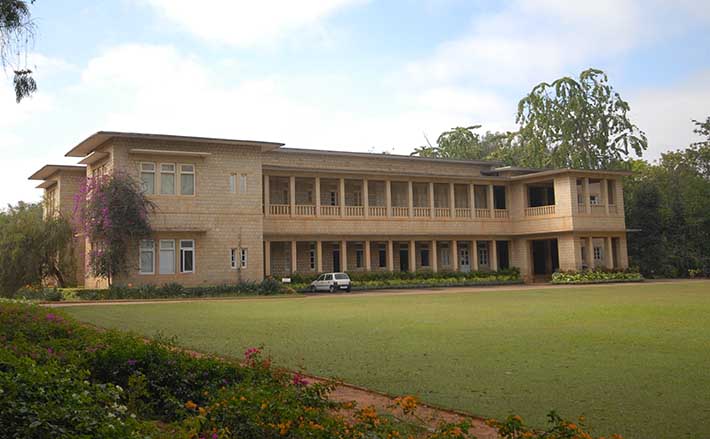
At the heart of the Silicon City of India stands the iconic Raman Research Institute probing into a range of research on Astronomy & Astrophysics, Light & Matter Physics, Soft Condensed Matter and Theoretical Physics and many more.
Founded in 1948 by Nobel Laureate, Sir C V Raman, to continue his studies and basic research after he retired from the Indian Institute of Science, RRI was restructured to become an aided autonomous research institute receiving funds from the Department of Science and Technology of the Government of India.
Astronomy being one of the focus areas of the institution, the Astronomy and Astrophysics group at the institute is continuously delving into the physical, chemical, and dynamic properties of celestial objects to unravel the mysteries of the universe that stares at us when we look up at the sky.
Energy release from a solar flare is broken and spans both over multiple locations and at different times—this finding by scientists by scientists of Raman Research Institute will lead to a better understanding of time and location of solar flares that affect the ionosphere and radio communications in Earth, and also release energetic particles into space.
The research conducted in the AA group at RRI can be broadly classified into four areas, namely Theoretical Astrophysics, Observational Astronomy, Experimental Astronomy, and Algorithms & Signal processing.
Theoretical Astrophysics that involves the development of analytical models and numerical simulations describing the dynamics, physical properties, and underlying physical phenomena in celestial objects like stars, planets, galaxies, interstellar medium, etc. Theorists also work on answering fundamental questions on the formation and evolution of the Universe, a branch of astrophysics called cosmology.
Observational Astronomy, on the other hand, uses telescopes built across the globe to study radiation from space across the entire electromagnetic spectrum – low frequency (long wavelength) radio waves to very high frequency (short wavelength and highly energetic) gamma rays.
Experimental Astronomy involves the design, construction, and operation of telescopes for very specific purposes to address key unsolved problems, and are strategically located around the world and in space.
Algorithms & Signal processing where a variety of methods and modelling are employed to amplify and or isolate the required astronomy signal from other foregrounds, backgrounds, and unwanted interference and confusion.
Scientists at the institution are also carrying out research on Chemistry, Liquid Crystals, Physics in Biology, and Signal Processing, Imaging & Instrumentation.
The soft condensed matter (SCM) group at RRI is engaged in research on liquid crystals and their chemical synthesis, colloids, polymers, nanocomposites, amphiphilic systems, physics, and chemistry of surfaces, and biological physic.
Recently, a research group from the institute has revealed interesting mechanical behaviour of the silk fiber of the spider. Such mechanical properties may be mimicked for designing future fibers that require a combination of flexibility and firmness. Such studies can, in the long run, help develop synthetic fibers that could mimic the unique mechanical properties of spider silk.
In another achievement of the group, Sayantan Majumdar and his students of the Soft Condensed Matter group at RRI, have proposed a novel and direct method for distinguishing between various viscosity states of dense suspensions under the application of varied stress. The research may help designing flexible, impact-resistant, protective gears using dense suspensions for injury prevention in sports and security applications.
Soft materials, constituted by molecules that are held together by weak inter-macromolecular forces, are characterized by complex structures and phase behaviour. Colloidal suspensions and emulsions such as milk and paint, polymeric and biological materials, foam, and liquid crystals are some common examples. The size of the molecules that constitute these materials is typically between a few nanometers and a few micrometers.
Inter-constituent interactions can be easily modified in soft materials, a feature that is particularly suitable for engineering new materials with interesting and useful properties. Their structural complexity and mechanical flexibility make soft materials ideal for many applications. Moreover, soft matter systems are a testing ground for theories and models of statistical physics.
The researchers of the Light and Matter Physics group at the institute, along with collaborators from the University of Rennes, France, demonstrated a new technique of decrypting encrypted information through optical technology.
The technology is called – FAST-QUAD (Full-field All-optical Single-shot Technique for Quadrature Demodulation). This technique has great potential for application – it can be used for encrypting and decrypting images, surveillance, navigation under poor visibility, optically imaging through tissues, and underwater vision. In addition, the technique is likely to open up possibilities for 3D ranging and imaging, optical communications, food quality analysis, and specialized scientific instrumentation.
Members of the Light and Matter Physics (LAMP) group at RRI are pursuing research in an area of light-matter interaction, which is a combination of Atomic, Molecular, and Optical (AMO) physics on the one hand and intense laser-produced plasmas on the other. Light-matter interactions are being investigated by this group in both classical and quantum domains using experiments as well as numerical and theoretical analysis.
The interactions are studied at very high plasma temperatures, room temperature, and at extremely low temperatures attained through laser cooling methods. The use of light from the highest energy densities to the single-photon regime allows an impressive range of energy scales to be investigated.
The research of the LAMP group stresses on demonstration of quantum logic, investigation of transport and localization properties of light in various random media, ultrafast laser-induced plasmas from solid targets, nonlinear optical properties of nanomaterials, laser cooling and trapping of atoms, molecular spectroscopy, cold collisions, response of cooled atoms to external fields, manufacture of single-photon sources, quantum communication, etc.
The major areas of research pursued by the Theoretical Physics group at the institute include statistical physics, soft matter physics (including physics in biology), gravitational waves, quantum gravity and general relativity and foundations of quantum mechanics. There are interfaces between the LAMP and SCM groups and collaborations with experimentalists working in the areas of foundational questions in quantum physics and biophysics, both within and outside the institute.






























